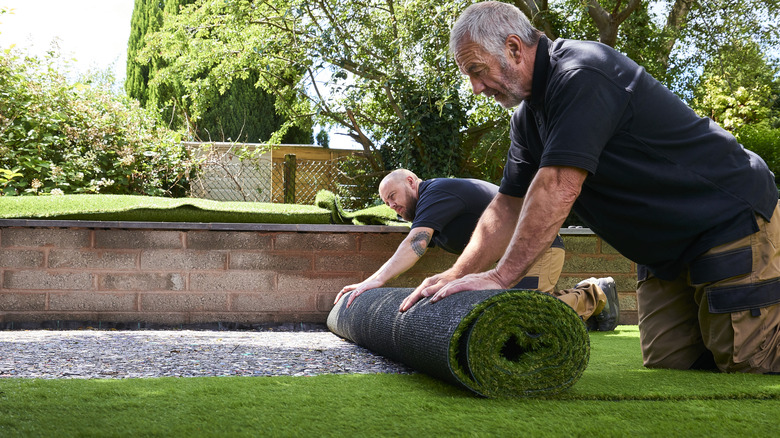Why Using Artificial Turf For Your Lawn Might Be A Huge Mistake
Artificial turf might seem like the perfect low-maintenance solution for a picture-perfect lawn, but it often comes with hidden drawbacks that can make it a costly and uncomfortable mistake. While it eliminates mowing and watering, plastic lawns are even worse than you think because they trap heat and remove vital living space for soil health and wildlife. On sunny days, the surface temperature of synthetic turf can soar past 130 degrees Fahrenheit, burning bare feet and even damaging nearby tree roots, which is perhaps the worst disadvantage of having artificial turf installed on your property.
Despite being advertised as maintenance-free, artificial turf still needs regular upkeep. Leaves, dust, and pet waste can build up and smell, especially in warm, humid climates. And these are just some of the hidden downsides to artificial turf you didn't know about. Without living roots to slow water down, runoff increases, which may lead to drainage issues or even mold under the surface. Plus, once turf reaches the end of its 10- to 12-year lifespan, it's typically hauled off to a landfill, where it could take centuries to decompose.
Even more concerning, many of these products contain synthetic rubber and chemicals that may leach into soil or groundwater. Artificial lawns also offer no advantages to pollinators or beneficial insects, making them a poor fit for eco-conscious gardeners. If you're rethinking your yard, natural and stylish alternatives can offer better value, cooler surfaces, and a more vibrant outdoor space.
Why living ground covers and lawns are the better choice
Unlike synthetic turf, living lawns and plantings offer natural cooling and soil enrichment. Research shows that turfgrass can be up to 102 degrees Fahrenheit cooler than artificial turf on a summer day. That cooling effect supports a more comfortable outdoor space while also benefiting surrounding trees and garden beds. Living lawns also help with water absorption, reducing runoff and erosion, and they provide vital habitat for pollinators, soil microbes, and other garden-friendly creatures.
For homeowners in warm regions, drought-tolerant plants like native succulents, cacti, and ornamental grasses offer texture and beauty without the upkeep of traditional grass. Xeriscaping is another smart approach, combining rocks, mulch, and low-water plants to create a striking, climate-adapted landscape. The xeriscaping trend can also help your garden in a drought, provided that you plant drought-tolerant plants and turfgrasses that will go dormant during a drought and then liven back up. Homeowners in cooler climates will benefit from moss gardens, clover lawns, or low-maintenance ground covers instead of artificial turf.
It's also worth checking local regulations before installing artificial turf. Some HOA codes restrict its use, and concerns about microplastics and heat buildup are certainly reasons to reconsider its place a residential yards. Ultimately, natural options not only look and feel better — they create a healthier home environment. By choosing living landscapes over synthetic ones, you'll enjoy a cooler, more sustainable yard that supports your local ecosystem and adds lasting value to your home.

